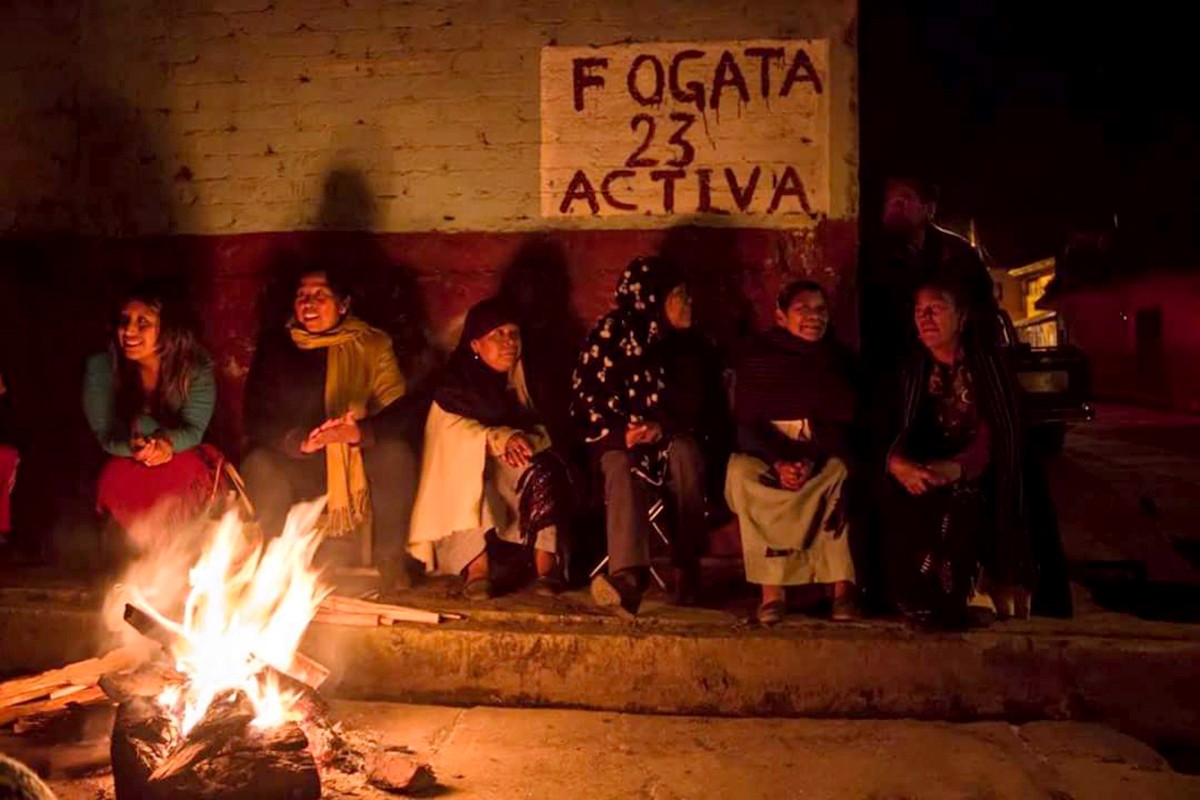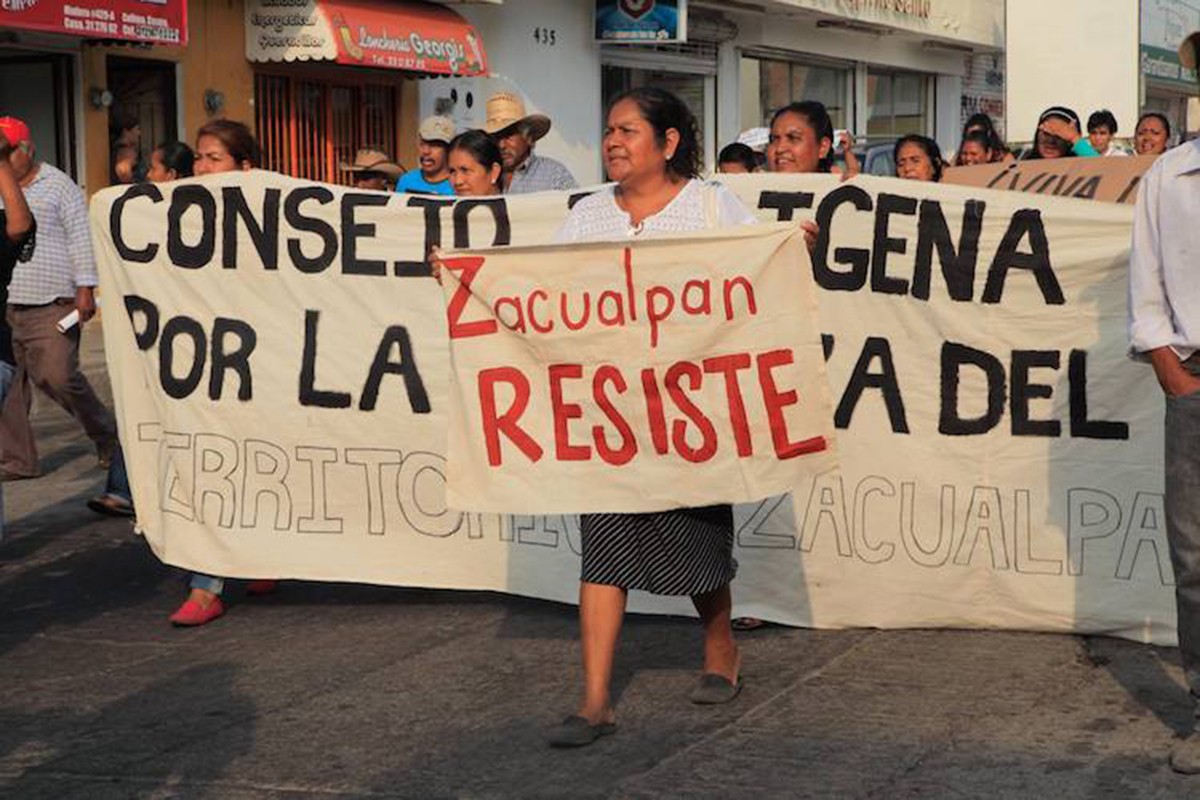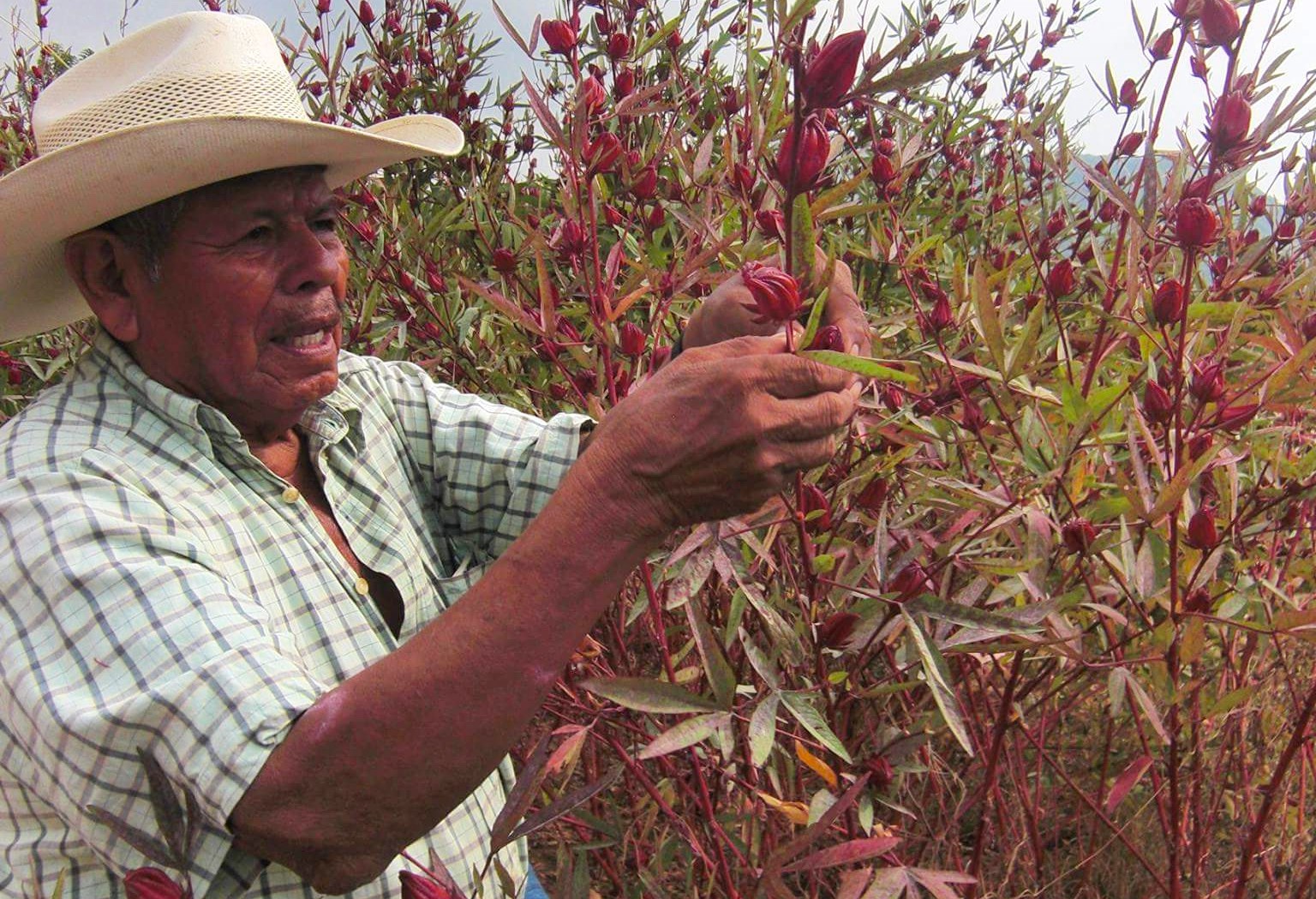Filed under: Analysis, Community Organizing, Indigenous, Land, Mexico, Repression, Southern Mexico

By Analy S. Nuño
In the last decade, indigenous and mestizo communities in Michoacán, Jalisco, and Colima have confronted developers, mining and other extractive industries, governmental authorities, and criminal gangs to protect their territories from dispossession and destruction. Along the way, they have come up against threats, disappearances, criminalization, and death.
The body of the P’urhépecha indigenous woman Guadalupe Campanur Tapia was found on January 16th, around the 15th kilometer of the Carapan-Playa Azul highway, in a place known as Irapio. She had disappeared several days earlier.
Guadalupe, 32, was a woman who had broken the mold of her community by joining the group of forest defenders and participating actively in the search for security, justice, and territorial reclamation. The journalist Alejandra Guillén, author of the book Guardians of the Territory: Security and Community Justice in Cherán, Nurío, and Ostula, defined her as “one of the critical voices who pointed out internal contradictions — because she knew that the struggle is built day by day, starting with the small and the everyday things.”
Guadalupe was the founder of the Community Patrol, the movement against illegal logging, and a member of the “Cherán K’eri: Knowing and Recognizing our Territory” project.
On many occasions, she carried out searches for community members who had been reported as disappeared. Her murder is the latest in a series of killings of activists and land defenders in the region, including Jalisco, Colima, and Michoacán, whose natural resources are targeted by both capitalist interests and criminal groups.
“This can be interpreted as a message to intimidate and silence those who genuinely aim to re-value life through community actions that go beyond resistance. It is also a means of terrorizing women, and, on top of everything, it fits within a broader ethnocidal technique intended to diminish the struggle for life carried on by the P’urhépecha community of Cherán,” wrote her friend, Carolina Lunuen.

Guadalupe Campanur Tapia. Photo: Facebook
Still, the attacks occurring in this region are only a sampling of the systematic attacks that have been carried out against social leaders, activists, and land defenders nationwide in the last decade.
Jalisco: The Owners’ Reply
2017 was one of the worst years for the defenders and activists of Jalisco:
In May, the Wixaritari brothers Miguel and Agustín Vázquez Torres were killed in their community by an armed commando. Miguel was active in the defense of the Wixárika people’s sacred places, as well as being one of the founders of the Wixárika Regional Council for the Defense of Wirikuta, and president of the Communal Property Commission of San Sebastián Teponahuaxtlán. He had headed the legal fight for the restitution of lands invaded by mestizos in the Huajimic area of La Yesca, Nayarit, and in September 2016, succeeded in recovering 184 hectares of the Piedra Bola and Bola Negra lands. Agustín, his brother, had graduated from law school with a specialization in human rights, and took on the role of promoter of indigenous and communal rights for the community.
December saw the murder of Salvador Magaña, a social leader of the Southern Coast region of Jalisco and activist in defense of stolen beaches. Always impeccably dressed and with a well-trimmed mustache and chatty, friendly manner, Magaña had quickly gained people’s trust. “The situation is very bureaucratic, very politicized and complicated. There are no clear steps forward, and it is because the state government would prefer that the people forget the issue, and let things stay as they are,” he argued in 2012, when he was serving, until 2015, as a councilor in La Huerta. At the time of his murder he was a municipal coordinator for the Citizens’ Movement political party.
Salvador Magaña denounces the distribution of government food vouchers from the PRI Municipal Committee in La Huerta Jalisco, prior to the beginning of an election campaign.
The Jalisco region is coveted by various interests. It includes natural coastal paradises, with white sand beaches and crystalline water, hard-to-access mountainous regions and watersheds, which facilitate the farming and transport of opium poppies, mineral extraction, and illegal logging of precious lumber such as rosewood.
In 2012, the Nahua activist Celedonio Monroy Prudencio reported the presence of armed illegal loggers hunting for rosewood in the buffer zone surrounding the Manantlán Biosphere Reserve. In October of the same year, an armed group raided his home and kidnapped him. He remains disappeared to this day. Gaudencio Mancilla, an organizer of the struggle against mining and illicit logging in the ejido of Ayotitlán, was illegally detained and tortured one year later, in August 2013. Strong, outgoing, and forged by working with the land, Mancilla was never seen without his woven cowboy hat. When he was detained by members of the state police, his detention was backed by the Jalisco state government, which argued that his detention was legal. “Whoever stands at the front runs the risk that something will happen to him or her – there are always threats, but there’s no way that we’ll give up just because of that,” Mancilla stated at the time.
In July 2015, about a hundred Nahuas from Ayotitlán, in the municipality of Cuautitlán de García Barragán, attempted to occupy the installations of the Peña Colorada mine, located in the neighboring state of Colima. They were repressed by the state police from Colima, upon the request by the company Ternium, which controls mineral extraction in the region. The indigenous people demanded compliance with the agreement that established that there would be a royalty payment of 20 percent per ton of material extracted, but the company refused to comply. The protest saw 33 community members beaten and arrested. What’s more, their lawyer, Eduardo Mosqueda Sánchez, was jailed in a maximum security prison, accused of robbery, property damage, and kidnapping. The Jalisco state government avoided intervening in the conflict, while the government of Colima incriminated the environmentalist lawyer.
One year earlier, Félix Monroy Rutilo, defending his land from being plundered by an iron mine (also owned by Ternium), faced intimidation and pressure in an attempt to dispossess him of 8 hectares, which would be used as a tailings dump for the mine. The attacks on the Monroy family date back as far as 1986, when his father, Abelino Monroy Sandoval, was murdered by a hitman who was presumably paid by the mining consortium, because he was unwilling to sell his land. In 1987, one of the workers for the consortium murdered his son, Alejandro Monroy Denis, supposedly under orders from higher-ups in the mining company.
The same patterns of dispossession have been seen in the tourism industry. In April 2016, the townspeople of Santa Cruz de la Soledad, east of Chapala, were surprised by a massive deployment of state police forces. The police presence was part of an official strategy to remove the board of directors of the ejido and impose a new one that would back the development of two mountains, El Junco and Cántaro, which have lakeside views. The opposition to this tourist development, which had a planned investment of 390 million pesos from private individuals in partnership with the Pension Institute of the State of Jalisco, resulted in harassment, bullying, threats, and attempts by both investors and Chapala municipal police to kidnap of the president of the board of directors, Martha Rodríguez García, and her daughter, María de Jesús López, the recognized attorney of the ejido.
In October of the same year during the general assembly of the José María Morelos ejido in Tomatlán, elements of the Jalisco Regional Special Forces used the same tactics to attempt to influence community decisions, blocking the attendance of ejido members who were opposed to the tourist mega-project known as New Cancún, which is planned to be built on the beach of Chalacatepec. At play in the assembly was the decision between recovering 1,200 hectares that the state government and a corporation known as Rasaland had stolen from the ejido, and the sale of land to investors who, along with 90 million dollars invested by the Pension Institute, plan to carry out the project that will be part of the “One & Only” resort chain.
This aggression is not only concentrated in the mountain zone. In Los Altos, townspeople resisted the flooding of their towns in order to build El Zapotillo dam for over 12 years. In 2010, members of the Committee to Save Temacapulín, Acasico, and Palmarejo were subjected to death threats for refusing to sell their land. Since then, the harassment has not stopped. On January 6 of last year, Emma Juárez – a member of the committee – was attacked by the PRI-supporting councilor from Cañadas de Obregón, Catalina Mejía Alvarado, and her husband, Héctor Chávez Saldivar, during the celebration of the community’s patron saint festival. This aggression was denounced before the regional delegate of the Attorney General for Zona Altos Sur Tepatitlán de Morelos, as well as the Jalisco State Commission on Human Rights, which granted a protective order in favor of the activist.
Colima: The Calm is Over
Just a few years ago, the small state of Colima occupied the lowest rankings of insecurity nationwide. But its calm status took a turn for the worse, and in the second half of 2017 it appeared on the registers as the most violent state in the country.
What happened? Its location — bordered by Jalisco to the north, Michoacán to the south, and the Pacific Ocean to the West — and its mountainous zones, formed by Cerro Gordo and the Perote and El Peón mountain ranges, turned it into a key region for drug trafficking.
In addition, its wealth of mineral resources, including iron, copper, gold, silver, zinc, lead, manganese, titanium, quartz, dolomite, and marble, among others, are being exploited by a variety of mining companies: the Peña Colorada Benito Juarez mining consortium, Ternium – Las Encinas, Mittalstel, and Gabfer, a Mexican corporation linked to Canadian transnationals.

Protest march against mining in Zacualpan. Photo: Indigenous Council for the Territorial Defense of Zacualpan.
This massive exploitation of resources, which exploded in the final years of former president Felipe Calderón’s six-year term, has brought threats, harassment, and persecution against members of the Indigenous Council for the Territorial Defense of Zacualpan, in response to their opposition to the project, which would affect at least 100 hectares, skirting the edges of a biosphere preserve. These threats and harassment have made it necessary the group’s leaders to move from place to place, as well as to seek protection from mechanisms set up for individuals involved in human rights defense.
The environmentalist organization Bios Iguana is in the same situation. The group’s organizer, Esperanza Salazar Zenil, was forced to leave the state, and members of the group have faced aggression, intimidation, boycotts, legal harassment, and even death threats. In March 2015, an international delegation was present during an the excessive police operation, involving riot police as well as state police and judicial police, unleashed by the authorities when the delegation tried to enter the community and interview residents.
Michoacán: Vicious Cruelty Against Indigenous Peoples
The complex puzzle of the community self-defense movement in Michoacán began with the formation of indigenous communal guard organizations in 2009, after several communities rose up to recover their lands, beaches, and mountains. Since that point, attacks on land defenders and social leaders have not ceased.
In June 2009, after having exhausted all legal and judicial pathways for the defense and recognition of their lands, a group of community members from Santa María Ostula, in the municipality of Aquila, went to the coast with the goal of recovering the place known as La Canaguancera, which had been occupied by small landholders originally from Colima and adjoining regions for several years. When they arrived in the area, they were greeted with gunfire. In response, the Nahua indigenous people from Ostula blocked access to 21 small towns, took back possession of their lands, founded the town of Xayakalan, and — two weeks later — assembled and armed their community police. The community published the Ostula Manifesto, in which they declared that, “The path before us is to continue exercising our historic right to autonomy and free self-determination.”
But the cost of the Nahua rebellion has been high. Early in 2011, community members Juan Faustino Nemesio and Nicolás de la Cruz — commanders of the Communal Guard — were murdered. In October, Pedro Leyva Domínguez, member of the Commission for the Defense of Communal Holdings, was murdered. He was also the representative of the Nahua people in the Movement for Peace with Justice and Dignity. Two months later, José Trinidad de la Cruz Crisóstomo, one of the primary leaders of the community, was kidnapped on the coastal highway when he was returning to his community accompanied by a procession from the Movement for Peace. Moments before the kidnapping, the Federal Police escort had pulled back. His body was found several days afterwards. 2011 also saw the first of several assassination attempts against Cemeí Verdía Zepeda, a community member, leader, and commander of the community police.

José Trinidad de la Cruz. Photo: Alejandra Guillén.
Don Trino Cristóstomo and Pedro Dominguez had been threatened by a known associate of the Knights Templar cartel, Priciliano Corona Sánchez, also known as Chalano. The Knights Templar cartel is the criminal group which, in the absence of state authorities, took control of the region in 2013. This takeover prompted the formation of a diverse movement of self-defense organizations in various regions around the state.
In Ostula, the Knights Templar murdered 32 community members and disappeared another six between 2008 and 2014.
Around 2013, both state and federal governments modified their strategy for breaking up the self-defense movement. They began to charge leaders and members of the community police organization with fabricated crimes. To date, more than 300 community members have been detained. The most well-known and well-covered in the media is José Manuel Mireles Malverde, leader of the self-defense group from Tepalcatepec, who was detained in 2014 for crimes against the public health and for carrying arms restricted for military use. Malverde was released on bail in May 2017.
Among indigenous leaders, the first to be captured was Agustín Villanueva, who had begun the movement in Aquila, as the former president of communal property. A false charge of kidnapping kept him in jail for four years and two months. On the day of his apprehension, eight community members were murdered, and 41 more were arrested alongside him and his brothers, Efraín and Vicente. His brothers are still incarcerated.
“We were all under threat, wrecked, and nobody wanted to work, because what little they made had to go to pay a quota — a protection fee for the Templars — and if you didn’t pay the Templars, then the Jalisco cartel would come, which was another group, worse than the Templars. “What the hell?!” we said, “What is this, anyway? We couldn’t take it anymore,” Villanueva stated in an interview, strong but suspicious, with the effects of prison visible in his eyes and posture.
In June 2015, federal and local police arrested Cemeí Verdía in the town of La Placita, accusing him of homicide and of trafficking in arms restricted for military use. In protesting his arrest, community members from Ostula blocked roads, which led to a military assault on the community. Iberto Reyes García, 12 years of age, was killed in the assault, and four other individuals were injured.
Cemeí Verdía Zepeda was released in December of the same year, after having the charges against him dropped, but in 2017, the Attorney General of the Republic circulated an arrest warrant against the leader of the self-defense movement in Ostula, along with four other leaders: Germán Ramirez Sánchez, who was in charge of the Aquila Municipal Security organization, Héctor Zepeda Navarrete, commander of the community police in Coahuayana, José Luis Arteaga Olivares, the mayor of Aquila, and Raúl Baltazar, an Aquila community member.
“They want to hit us from all sides, but we’re not going to let them,” warned Cemeí.
The town of Cherán is another example of the extreme cruelty of both criminal groups and state and federal authorities against indigenous groups. Between 2009 and 2011, 23 community members were murdered, and another five were disappeared. Among them were Francisco de Asís Manuel (president of the Ostula Communal Property Commission), and Máximo Magno Valladares (representative of the leadership of El Potrero).
In May of 2011, the community mobilized and ceased to recognize the municipal authorities. The process that followed resulted in the creation of the Communal Government, which allows for rule by usos y costumbres, or indigenous customary law, as recognized by the Supreme Court.
This unprecedented judicial victory allowed Cherán to become the only autonomous indigenous community in the state and resulted in a period of relative peace… until the murder of Guadalupe Campanur.





